|
|
St Andrew, Archbishop of Crete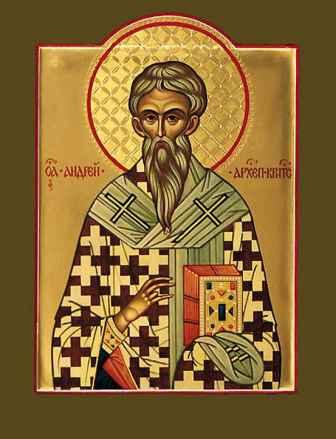 Born in Damascus of Christian parents, he was dumb until the age of seven. When his parents took him to church for Communion, the power of speech was given to him. Such is the divine power of Communion. He went to Jerusalem at the age of fourteen and was tonsured in the monastery of St Sava the Sanctified. In his understanding and ascesis, he surpassed many of the older monks and was an example to all. The Patriarch took him as his secretary. When the Monothelite heresy, which taught that the Lord had no human will but only a divine one, began to rage, the Sixth Ecumenical Council met in Constantinople in 681, in the reign of Constantine IV. Theodore, Patriarch of Jerusalem, was not able to be present at the Council, and sent Andrew, then a deacon, as his representative. At the Council, Andrew showed his great gifts: his articulateness, his zeal for the Faith and his rare prudence. Being instrumental in confirming the Orthodox faith, Andrew returned to his work in Jerusalem. He was later chosen and enthroned as archbishop of the island of Crete. As archbishop, he was greatly beloved by the people. He was filled with zeal for Orthodoxy and strongly withstood all heresy. He worked miracles through his prayers, driving the Saracens from the island of Crete by means of them. He wrote many learned books, poems and canons, of which the best-known is the Great Canon of Repentance which is read in full on the Thursday of the Fifth Week of the Great Fast. Such was his outward appearance that, "looking at his face and listening to the words that flowed like honey from his lips, each man was touched and renewed". Returning from Constantinople on one occasion, he foretold his death before reaching Crete. And so it happened. As the ship approached the island of Mitylene, this light of the Church finished his earthly course and his soul went to the Kingdom of Christ, in about the year 740. Born in Damascus of Christian parents, he was dumb until the age of seven. When his parents took him to church for Communion, the power of speech was given to him. Such is the divine power of Communion. He went to Jerusalem at the age of fourteen and was tonsured in the monastery of St Sava the Sanctified. In his understanding and ascesis, he surpassed many of the older monks and was an example to all. The Patriarch took him as his secretary. When the Monothelite heresy, which taught that the Lord had no human will but only a divine one, began to rage, the Sixth Ecumenical Council met in Constantinople in 681, in the reign of Constantine IV. Theodore, Patriarch of Jerusalem, was not able to be present at the Council, and sent Andrew, then a deacon, as his representative. At the Council, Andrew showed his great gifts: his articulateness, his zeal for the Faith and his rare prudence. Being instrumental in confirming the Orthodox faith, Andrew returned to his work in Jerusalem. He was later chosen and enthroned as archbishop of the island of Crete. As archbishop, he was greatly beloved by the people. He was filled with zeal for Orthodoxy and strongly withstood all heresy. He worked miracles through his prayers, driving the Saracens from the island of Crete by means of them. He wrote many learned books, poems and canons, of which the best-known is the Great Canon of Repentance which is read in full on the Thursday of the Fifth Week of the Great Fast. Such was his outward appearance that, "looking at his face and listening to the words that flowed like honey from his lips, each man was touched and renewed". Returning from Constantinople on one occasion, he foretold his death before reaching Crete. And so it happened. As the ship approached the island of Mitylene, this light of the Church finished his earthly course and his soul went to the Kingdom of Christ, in about the year 740.St Martha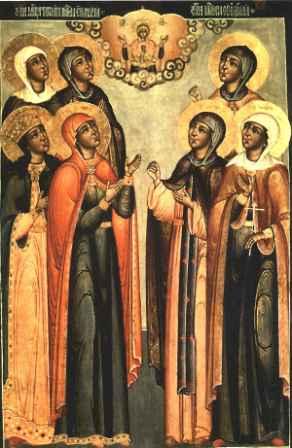 She was the mother of St Simeon of the Wonderful Mountain (see May 24th). Utterly consecrated in her soul, she had no thought of marriage. When her parents betrothed her to a young man, she planned to leave their home and retire from the world, but St John the Baptist appeared to her and counselled her to fulfill the desire of her parents and marry, which she did. From this marriage was born the great St Simeon, the ascetic of the Wonderful Mountain. She followed the practice of rising at midnight for prayer; she gave help to the needy with great compassion, visiting the poor and serving the sick. A year before her death, she saw a host of angels with candles in their hands, and learned from them the hour of her death. Learning this, Martha gave herself yet more fervently to prayer and good works. She entered peacefully into rest in 551, and was buried near the pillar of her son Simeon. She appeared a number of times after her death, to teach people and to heal the sick, and appeared in the following way to the superior of Simeon"s community: after her funeral, the abbot kept the lamp burning on her grave, intending never to let it go out. But, after a certain time, the monks became lazy and the lamp went out. Then the superior was taken ill, and the saint appeared to him and said: "Why are you not lighting the lamp on my grave? Know that the light of your candles is not needful to me, because God has made me worthy of His eternal, heavenly light, but it is needful for you. When you burn a light on my grave, you urge me to pray to the Lord for you." From this it is clear that the goal of our veneration of the saints is to remind them, who are worthier than we, to pray to God for us and for our salvation. She was the mother of St Simeon of the Wonderful Mountain (see May 24th). Utterly consecrated in her soul, she had no thought of marriage. When her parents betrothed her to a young man, she planned to leave their home and retire from the world, but St John the Baptist appeared to her and counselled her to fulfill the desire of her parents and marry, which she did. From this marriage was born the great St Simeon, the ascetic of the Wonderful Mountain. She followed the practice of rising at midnight for prayer; she gave help to the needy with great compassion, visiting the poor and serving the sick. A year before her death, she saw a host of angels with candles in their hands, and learned from them the hour of her death. Learning this, Martha gave herself yet more fervently to prayer and good works. She entered peacefully into rest in 551, and was buried near the pillar of her son Simeon. She appeared a number of times after her death, to teach people and to heal the sick, and appeared in the following way to the superior of Simeon"s community: after her funeral, the abbot kept the lamp burning on her grave, intending never to let it go out. But, after a certain time, the monks became lazy and the lamp went out. Then the superior was taken ill, and the saint appeared to him and said: "Why are you not lighting the lamp on my grave? Know that the light of your candles is not needful to me, because God has made me worthy of His eternal, heavenly light, but it is needful for you. When you burn a light on my grave, you urge me to pray to the Lord for you." From this it is clear that the goal of our veneration of the saints is to remind them, who are worthier than we, to pray to God for us and for our salvation.St. Donatus of Libya, bishopHieromartyr Theodore, bishop of Cyrene in Libya (310)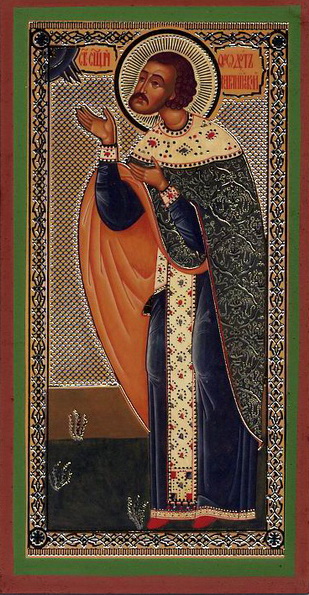 The PriestMartyr Theodore, Bishop of Cyrenia, lived during the reign of the emperor Diocletian (284-305). Skilled at writing, and having accomplished great mastery in his beloved task, he transcribed many a copy of books for the churches. His son by birth Leo denounced him to the district governor, Dignianus, saying that his father possessed Christian books and was turning people away from idol-worship, and instead drawing them to faith in Christ the Saviour. Saint Theodore was brought to trial... The PriestMartyr Theodore, Bishop of Cyrenia, lived during the reign of the emperor Diocletian (284-305). Skilled at writing, and having accomplished great mastery in his beloved task, he transcribed many a copy of books for the churches. His son by birth Leo denounced him to the district governor, Dignianus, saying that his father possessed Christian books and was turning people away from idol-worship, and instead drawing them to faith in Christ the Saviour. Saint Theodore was brought to trial...Martyrs Theodotus and Theodota at Caesarea in Cappadocia (108)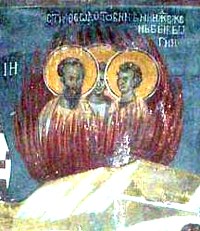 Saint Theodotus suffered martyrdom during the reign of Trajan because he refused to sacrifice to idols. Saint Theodotus suffered martyrdom during the reign of Trajan because he refused to sacrifice to idols. Martyrs Cyprilla, Aroa, and Lucia (310)The holy women Cyprilla, Lucia, and Aroa were executed with St Theodore of Cyrene during the reign of the emperor Diocletian (284-305), as were all who were baptized by the holy bishop.
Hieromartyr Theophilus
St. Menignus, monk
St. Asclepias the Wonderworker
St Sava of Gornji Karlovac hieromartyr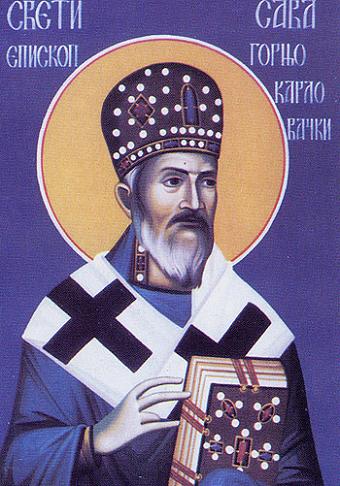 Our father among the saints Sava (Triajich) of Gornji Karlovac (Serbian: Свети свештеномученик Сава горњокарловачки) was a bishop of the Church of Serbia, who during World War II was arrested, tortured, and martyred by enemy Italian and Croatian personnel.
Svetozar Trlajich (Светозар Трлајић) was the son of Stephen and Jelisaveta (maiden name Karakaševich). He was born in Mol on July 18, 1884. His education included primary school in his hometown, grammar school in Novi Sad, and seminary in Sremski Karlovtsy. Svetozar graduated from the Faculty of Law at the University of Belgrade and passed the qualifying examination for judges at the Faculty of Law in Zagreb.
In 1909, Svetozar was ordained deacon by the Bishop of Timisoara and then presbyter ten days later. As a parish priest he served at parishes in Peška and Bašaid. Early in 1927, he was appointed to an administrative position, and later principal secretary, of the Holy Synod of Bishops of the Church of Serbia. A widower, he took monastic vows on October 27, 1929 in the Krushedol Monastery, being tonsured with the name Sava. Soon afterwards he became rector and archimandrite of the Krushedol Monastery. On September 30, 1930, Sava was elected Auxiliary Bishop of Sremski. He was consecrated in Sremski Karlovci by Patriarch Barnabas, Bishop Emilijan of Timok, Bishop Jovan of Niš, Bishop Tihon of Zahumlje-Herzegovina, and Bishop Simeon of Zletovo-Strumica. As Patriarchal Vicar Bp. Sava chaired the diocesan council of the Archdiocese of Belgrade-Karlovtsy. From early 1937, Bp. Sava chaired the ecclesiastical court. He was appointed Bishop of Gornji Karlovac on June 22, 1938, with his residence in Plashkom. After the death of Bishop Miron of Pakrac in 1941, he was also named administrator of the Diocese of Pakrac.
After the invasion of Yugoslavia and the formation of an independent Croatian state, Plashkom was first occupied by Italian forces and then turned over to the Ustashi Croatians in late 1941. Bp. Sava and nine priests were then taken hostage. On [[May 23[[, 1941, Ustashi occupied the bishop's residence and expelled Bp. Sava. On June 8, the notorious executioner Joseph Tomlenovich ordered all diocesan money and records to be handed over to the Ustashi. Bp. Sava refused the Ustashi order to leave his diocese and go to Belgrade. Not wanting to abandon his flock, he refused. Bp. Sava was arrested on June 17, 1941, and confined, together with three other Serbian priests and thirteen eminent Serbian laymen, in a stable of the Ustashi Joseph Tomlenovich in Plaskom. After experiencing intense torture, Bishop Sava and the priests, Bogoljub Gakovich, Đuro Stojanovich, and Stanislav Nasadilo, were chained and taken to Gospich concentration camp on July 19. There, they were tortured until mid August. At that time Bishop Sava was taken together with 2000 Serbs toward the Velebit Mountain. Somewhere on this mountain he suffered a martyr’s death together with thousands of other Orthodox Serbs. The site where Bishop Sava died is still unknown.
In 1998, at the regular session of the [Holy Synod|Holy Assembly of Bishops]] of the Serbian Orthodox Church Bishop Sava was glorified and entered on the list of names of the Serbian Church saints as hieromartyr. Our father among the saints Sava (Triajich) of Gornji Karlovac (Serbian: Свети свештеномученик Сава горњокарловачки) was a bishop of the Church of Serbia, who during World War II was arrested, tortured, and martyred by enemy Italian and Croatian personnel.
Svetozar Trlajich (Светозар Трлајић) was the son of Stephen and Jelisaveta (maiden name Karakaševich). He was born in Mol on July 18, 1884. His education included primary school in his hometown, grammar school in Novi Sad, and seminary in Sremski Karlovtsy. Svetozar graduated from the Faculty of Law at the University of Belgrade and passed the qualifying examination for judges at the Faculty of Law in Zagreb.
In 1909, Svetozar was ordained deacon by the Bishop of Timisoara and then presbyter ten days later. As a parish priest he served at parishes in Peška and Bašaid. Early in 1927, he was appointed to an administrative position, and later principal secretary, of the Holy Synod of Bishops of the Church of Serbia. A widower, he took monastic vows on October 27, 1929 in the Krushedol Monastery, being tonsured with the name Sava. Soon afterwards he became rector and archimandrite of the Krushedol Monastery. On September 30, 1930, Sava was elected Auxiliary Bishop of Sremski. He was consecrated in Sremski Karlovci by Patriarch Barnabas, Bishop Emilijan of Timok, Bishop Jovan of Niš, Bishop Tihon of Zahumlje-Herzegovina, and Bishop Simeon of Zletovo-Strumica. As Patriarchal Vicar Bp. Sava chaired the diocesan council of the Archdiocese of Belgrade-Karlovtsy. From early 1937, Bp. Sava chaired the ecclesiastical court. He was appointed Bishop of Gornji Karlovac on June 22, 1938, with his residence in Plashkom. After the death of Bishop Miron of Pakrac in 1941, he was also named administrator of the Diocese of Pakrac.
After the invasion of Yugoslavia and the formation of an independent Croatian state, Plashkom was first occupied by Italian forces and then turned over to the Ustashi Croatians in late 1941. Bp. Sava and nine priests were then taken hostage. On [[May 23[[, 1941, Ustashi occupied the bishop's residence and expelled Bp. Sava. On June 8, the notorious executioner Joseph Tomlenovich ordered all diocesan money and records to be handed over to the Ustashi. Bp. Sava refused the Ustashi order to leave his diocese and go to Belgrade. Not wanting to abandon his flock, he refused. Bp. Sava was arrested on June 17, 1941, and confined, together with three other Serbian priests and thirteen eminent Serbian laymen, in a stable of the Ustashi Joseph Tomlenovich in Plaskom. After experiencing intense torture, Bishop Sava and the priests, Bogoljub Gakovich, Đuro Stojanovich, and Stanislav Nasadilo, were chained and taken to Gospich concentration camp on July 19. There, they were tortured until mid August. At that time Bishop Sava was taken together with 2000 Serbs toward the Velebit Mountain. Somewhere on this mountain he suffered a martyr’s death together with thousands of other Orthodox Serbs. The site where Bishop Sava died is still unknown.
In 1998, at the regular session of the [Holy Synod|Holy Assembly of Bishops]] of the Serbian Orthodox Church Bishop Sava was glorified and entered on the list of names of the Serbian Church saints as hieromartyr. |